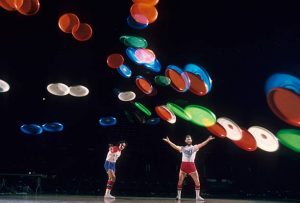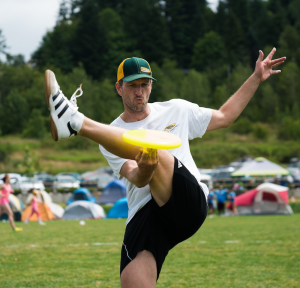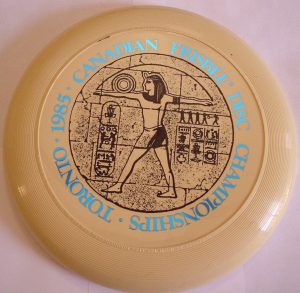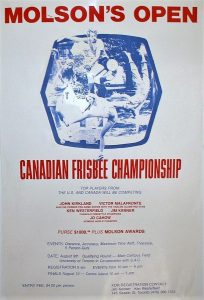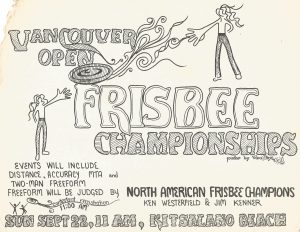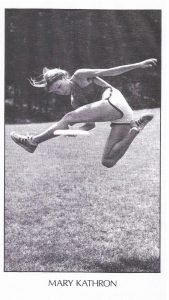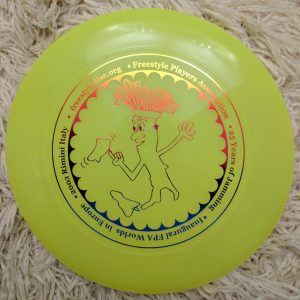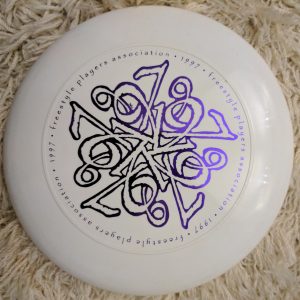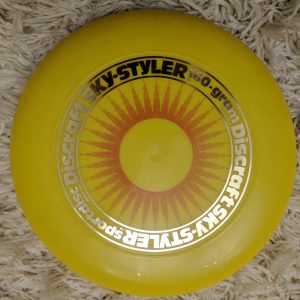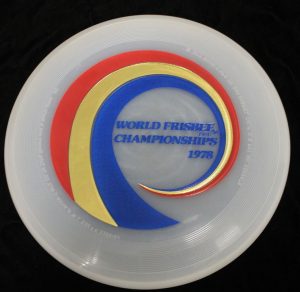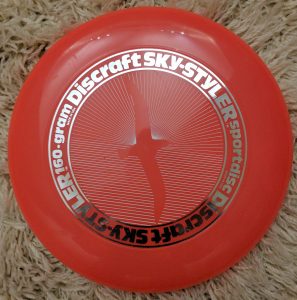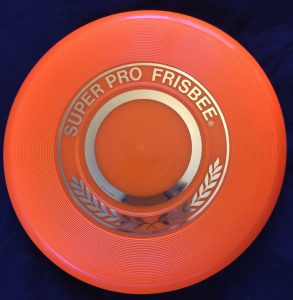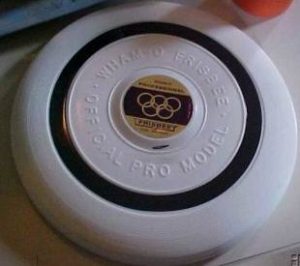 Although tipping the disc got started relatively early in the history of Frisbee play, and preceded the origin of freestyle competition, there is no known historical evidence of the delay move being done in any period of pre or post plastic disc play before mid-1975. The delay came into being only after freestyle competition was born and on its way to becoming a sport. The move came out of the creative crucible of the New York City freestyle scene in the mid 70’s that included Kerry Kollmar, Freddie Haft, Peter Bloeme, Mark Danna, and several other New York players of that era. None of these players were at the very first competitive freestyle event at the 1974 Canadian open. Kerry and Mark Danna were at the 1974 AFDO and were jamming up a storm, but were not seen doing anything remotely like a delay move. Kerry and Mark were also at the 1974 Jersey Jam, and neither one of them hinted at a delay move there either. They also attended the 1975 Octad, and competed in the freestyle event there, but still did not demonstrate any type of delay move.
Although tipping the disc got started relatively early in the history of Frisbee play, and preceded the origin of freestyle competition, there is no known historical evidence of the delay move being done in any period of pre or post plastic disc play before mid-1975. The delay came into being only after freestyle competition was born and on its way to becoming a sport. The move came out of the creative crucible of the New York City freestyle scene in the mid 70’s that included Kerry Kollmar, Freddie Haft, Peter Bloeme, Mark Danna, and several other New York players of that era. None of these players were at the very first competitive freestyle event at the 1974 Canadian open. Kerry and Mark Danna were at the 1974 AFDO and were jamming up a storm, but were not seen doing anything remotely like a delay move. Kerry and Mark were also at the 1974 Jersey Jam, and neither one of them hinted at a delay move there either. They also attended the 1975 Octad, and competed in the freestyle event there, but still did not demonstrate any type of delay move.
Kerry and Mark attended the 1975 AFDO tournament as well, and this time Freddie Haft was along with them. It is notable that amidst the constant jamming during the whole weekend of that 1975 AFDO event, no one was observed doing or attempting a delay move, even Freddie Haft or Kerry Kollmar.
However, Freddie Haft did attempt to hold a delay a few times during his routine and succeeding to hold at least one delay attempt for a tad over 3 seconds. Since a delay type move had never been seen before, the response from the spectators was enormous. It was apparent that something new was being seen for the very first time, and all were eager to get out there and try this new thing.
Although the delay move sparked great interest in the other players, it didn’t really catch on with most of the freestylers until the beginning of the 1977 season. In the beginning, it appeared that holding delay over 3 or 4 seconds in duration was nearly impossible, and perhaps this discouraged the veteran freestylers and newcomers alike from spending too much time trying to develop the move. Most everyone except for Richie Smits however. Richie was determined to master the delay, and master it he did.
Richie wasn’t at the 1975 Jersey Jam freestyle event, and no one who was there did any delay work. Everyone seemed to be working hard on multiple tipping instead. The freestylers appeared to be in awe of a new young kid named Erwin Velasquez who had total and complete control of multiple tipping, not only from the usual over the head position, but he was doing something new that we had not seen: multiple underhand tipping below the waist line, all with complete control. That appeared to be the direction that freestyle was headed in at that time. The delay move as displayed by Freddie Haft seemed almost forgotten.
But Richie Smits did attend the 1976 Ann Arbor indoor NAS event, and he brought along with him two new wrinkles, a container of some sort of slippery stuff with which he coated the underside of his disc, and a thimble on his finger. Between the reduction in friction from the slick on the disc, and the further friction reducing thimble, everyone got a renewed look at the delay, which Richie, and Richie alone, was able to do with complete control. He seemed able to delay the disc for as long as it had spin. His move was to receive a throw with heavy zzzzs, let it float down onto his thimble finger, and then hold the delay for 10 to 15 seconds. Everyone was amazed at this new development in freestyle, and ogled Richie’s display. In retrospective irony, an obscure ultimate player showed up at the 1976 Ann Arbor tournament. Being somewhat of a newcomer to the Frisbee scene and not knowing too many players, he needed to find a freestyle partner and hooked up with Richie Smits. This newcomer turned out to have considerable Frisbee skills. With some of Richie’s slippery slick stuff and a little coaching, he soon got the hang of the delay and was also doing it pretty well himself. But it was his superb throwing, catching and multiple tipping skills that caught the eyes of the crowd, many of who were exclaiming “Who is this guy?” Little did we know what was going to be coming from this new guy, who was competing in his first ever freestyle event. The new guy? None other than Jens Velasquez!
Because of Richie’s example and his friction reducing methods, players started to take a more serious look at the delay move.
As the 1976 Freestyle season progressed, the delay began to be used by an increasing number of players here and there, but no one displayed the skills and expertise with the move as did Richie and his regular partner freestyle partner Joey Hudoklin. Their mastery of the delay and how it could be used in a freestyle routine was way ahead of the curve.
Despite this growth of the delay move, it still was not universally used by freestylers, and the top two teams of the 1976 WFC Freestyle event were evidence of this. Jen’s and Erwin took first place, nosing out Doug Corea and Dave Marini, the top team throughout the 1976 NAS series. Neither of these top two teams used the delay move as part of their freestyle routines all season long, opting instead for the tried and true multiple tipping.
But as the 1977 season rolled around, the delay had become a widely popular part of jamming, and soon became an integral part of freestyle competition in general.
Thanks to the Freestyle Players Association (FPA) for sharing this information with FrisbeeGuru.com.
The entire document is stored on FreestyleDisc.org, as is the FPA’s Hall of Fame.



